Yet another black church fire frays already tender nerves
Loading...
Almost exactly twenty years after it was burned down in a hate crime, the Mount Zion African Methodist Episcopal church in the small town of Greeleyville, South Carolina, was once more caught in flames, leaving authorities to investigate and a pained African-American congregation to wonder aloud how this could have happened – again.
No one was believed to be inside the church at the time. Greeleyville is a town of about 400 people around 50 miles north of Charleston, where nine people were killed June 17 in a suspected racially motivated shooting, according to the Associated Press.
“The fire was one of six at black churches in the past two weeks, and one of hundreds,possibly thousands, in the past two centuries,” reported The Washington Post. “If Tuesday’s fire turns out to have been purposefully set, it will be at least the third arson at an African American church since last month’s massacre at Emanuel AME in Charleston, S.C.”
Federal authorities are investigating the other five church fires, all in the South. So far, the fires don’t appear to be related. Two others, one in Charlotte, N.C. and Knoxville, Tenn., are being investigated as arson, and another in Macon, Ga. has been deemed “suspicious,” reported NPR News. Another church in Tallahassee, Fla., was found to have caught on fire from electrical problems, while authorities said the flames in Gibson County, Tenn., likely came from lightning.
But that didn’t stop a tense community of African-American congregations and social media from weighing in with their own theories. Tensions had already been mounting in the hours before Tuesday’s fire at Mount Zion was discovered, as the NAACP warned black churches on Twitter to stay vigilant from possible arson attacks. A trending hashtag asked, “#WhoIsBurningBlackChurches?”
Mount Zion AME Church burned down on June 20, 1995. Two Ku Klux Klan members pleaded guilty to starting that fire and a second at another predominantly black church, and were each sentenced to nearly two decades in prison, reported the Associated Press.
State Law Enforcement Division Chief Mark Keel said Tuesday that officials would be on the scene with dogs and other investigative tools first thing Wednesday morning.
Chief Keel mentioned the strong rainstorms in Greeleyville, not ruling out the possibility that lightning could have caused the fire. "Talked to a guy who said they had a lot of lightning down there tonight,” he said. “I don't know whether that had anything to do with it at all."
Williamsburg County Councilman Eddie Woods Jr., said he had gotten out of bed to drive to the church after hearing about the fire.
“That was a tough thing to see,” Councilman Woods said. “It is hurting those people again. But we're going to rebuild. If this was someone, they need to know that hate won't stop us again.”
This report contains material from the Associated Press.







